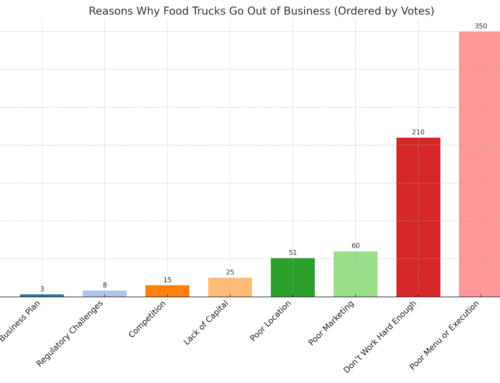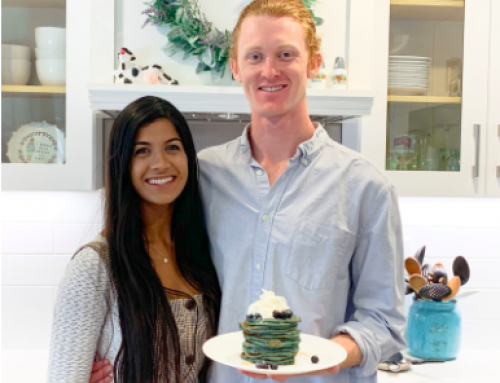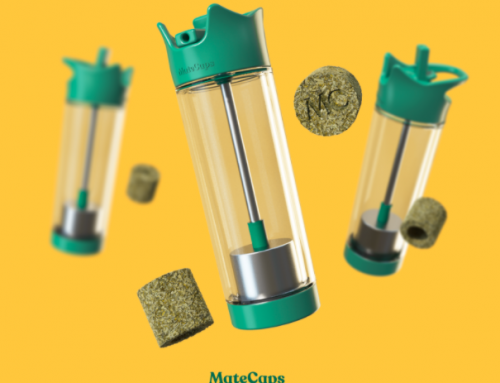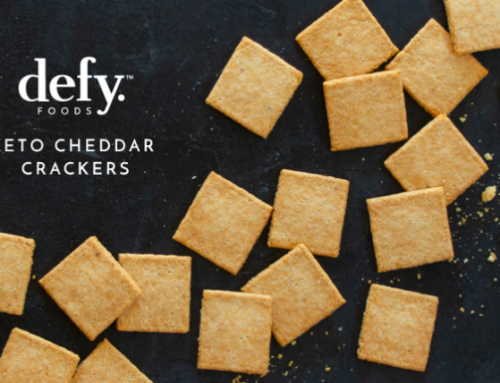Hello! Who are you and what food business did you start?
Hello to you! We are Zach and James, childhood friends and co-founders of Bissy Energy, an innovative and exciting social enterprise that crafts delicious, plant-based alternatives to coffee, tea, and energy drinks. Both college athletes, we were on a quest to find a healthy, great tasting, alternative to coffee. It wasn’t until Zach read a book written about his great grandfather’s life as an igwe (chief) in Onitsha, Nigeria that we arrived at the answer; kolanut.
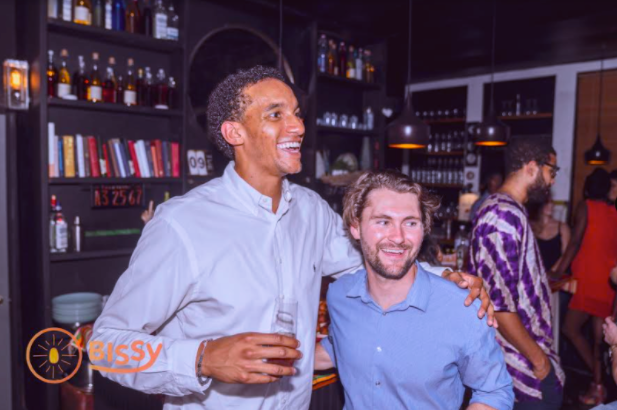
Bissy Energy co-founders Zach (left) and James (right).
In Nigeria it is believed that the kola tree was the first to grow and therefore the first to bear fruit. This belief has made kola a cultural and spiritual staple for thousands of years and is still the main source of caffeine for Nigerians today. There is a saying in Nigeria, “He who brings kola, brings life”
Our flagship product is a single origin kola powder that is sourced directly from our smallholder farmer partners in Southwest Nigeria. Together with our farmers, the Cocoa Research Institute of Nigeria, and our processing partners, Bissy will soon be the first to certify kolanut as a Fair Trade ingredient, thereby making us the first ever registered Fair Trade operators in Nigeria’s 60 year history.
In addition to our powders, we also have a limited supply of our original product, a delicious, 100% plant based energy shot that uses kolanut as the source of caffeine. In the last year and a half we have successfully completed a kickstarter for $30,300 and took first place in Orgain’s Grants for Greater Good competition earning us $50,000 and a number of PR and marketing opportunities we would not otherwise have had. We hope to expand our product line into new categories in 2021.
What’s your current revenue?
Revenue has been steadily climbing since our kickstarter ended a little over one year ago and we are now pulling in over $3,000 a month in online sales and from a small group of natural food retailers in Washington and California.
How did you come up with the idea for a kolanut energy powder?
We both grew up in the same town in Kennewick, Washington and met through our youth basketball team when we were 8 years old. We quickly became friends over our shared love of sports, the outdoors, and generally getting up to no good. As we grew up we went to the same middle and high schools, excelling at sports and in business classes.
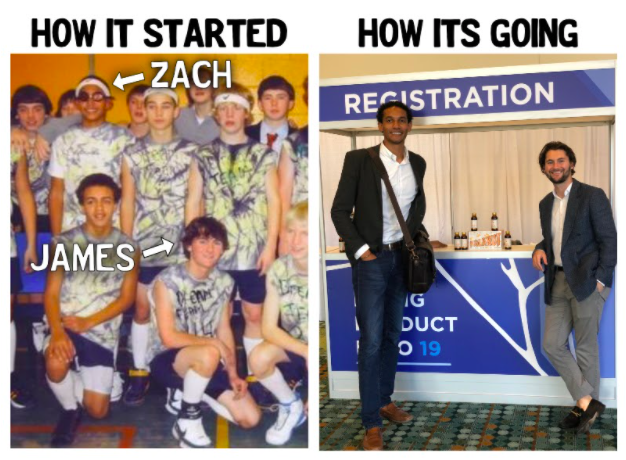
How it all started.
After 10 years we went our separate ways for college where Zach pursued a degree in Political Science from Columbia University in New York City, playing basketball on scholarship for the Lions. Meanwhile, James pursued a degree in Finance at Pacific Lutheran, playing football on scholarship for the Lutes. Our love for sports, nutrition, business, and civics kept us close throughout college and by the time we graduated we knew we wanted to pursue a social venture together but when and how we didn’t know.
Zach working as a corporate paralegal and James working in civil litigation, we were looking for an alternative to coffee that could help us keep up with new jobs and busy social lives in the city. We began experimenting with various teas, energy drinks, and energy shots but had trouble finding the right fit. Then, one day while in Kennewick visiting his family, Zach found an old book on his family’s bookshelf.
The book was the only copy of its kind, written by Zach’s uncle about his great-grandfather’s life as an Igwe in Onitsha, Nigeria. As Zach read, he began to notice a common trend; kolanut was mentioned over and over again. Zach had heard tales of kola growing up from his father, but did some more research and found that kola contained three times more caffeine per gram than coffee and also contained a special molecule called theobromine that dilates red blood cells in the lung wall, allowing the cells to carry more oxygen through the body to the brain and muscles.
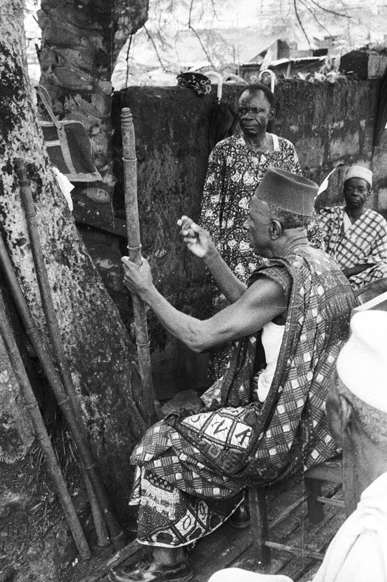
Zach’s great grandfather blessing the kola.
Zach immediately ordered every form of raw kola he could find on Amazon and spent the next week experimenting. Convinced, he told James what he had discovered and once James tried it for himself he was immediately hooked. Weeks went by and productivity soared, much to the delight of our respective bosses, as we shopped kolanut around in our social circles. One thing was abundantly clear, no one knew what kolanut was, but when they heard the story about its significance in Nigeria and its potency they were immediately intrigued.
This led us to a of week of obsessive market research on various industries from energy bites and bars to energy drinks and energy shots. There were zero consumer packaged goods on the market that used kolanut for its stimulating effect; we had found our venture.
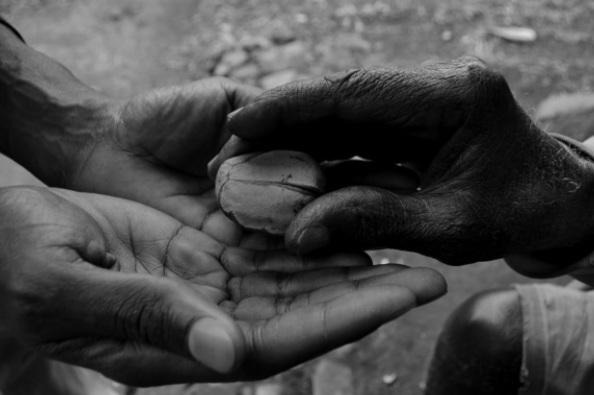
Gifting the kola.
Working our jobs by day and decreasing the useful life of our laptops by years in the span of a few long weeks, we banged out the beginnings of a brand and a business plan that aimed to disrupt the energy shot market with a delicious, natural, 100% plant based energy shot that had 160mg of caffeine and as little sugar as possible without sacrificing flavor.
This led to a weekend retreat at an AirBNB outside of Sausalito, CA where, armed with a saucepan and just about every ingredient we could find in Whole Foods, we developed our first rough formula.
Once we had the formula, we worked with a friend to organize a community event back in Eastern Washington where we would attempt to break a world record for the biggest game of knockout (basketball game) ever played while also hosting a 15 business street fair outside the gym in the parking lot at the same time. This is where we had our first Bissy booth and where we tested our homemade concoction on our hometown community. It was an absolute hit.
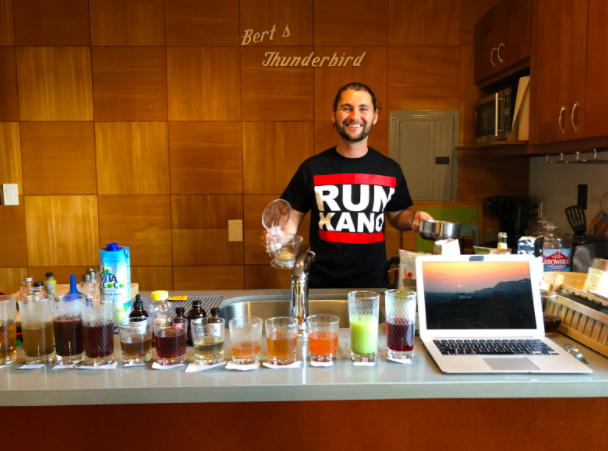
Inside the recipe development process.
Take us through the process of developing your kolanut powder?
The initial validation we received from our friends, family, and community on our homemade formula sent us on the hunt for a professional beverage development company to help us take things to the next level. Eventually we settled on a fantastic partner out of Edison, New Jersey called MetaBrand.
Over the course of a few months we worked closely with MetaBrand’s team through a number of iterations, each time testing them with friends and family who had experience in food and beverage as chefs, wine tasters, yelp reviewers, etc. to make sure our formula was delicious to even the most critical palates. After four iterations we landed on our first formula.

Iteration #1, #2, and #3 – our first attempts at a commercial product.
While working out the formula we were also on the search for co-manufacturers who could help us alleviate some of the other pain points we identified with the current energy shot market in addition to poor tasting products and overcomplicated artificial ingredients.
- We didn’t like the size of the mouth on the current shot bottles. They already tasted bad enough, the small mouth only prolonged the agony and turned the “shot” into more of a slow pour.
- We committed ourselves to zero plastic and the only shot sized bottle offerings in the US market were plastic. Finding glass bottles proved to be a really big challenge
James, having studied and worked briefly in Bangkok, Thailand, was familiar with South East Asia’s style of energy energy shots, 3.4 oz glass bottles with aluminum caps. At the time a popular Kickstarter by the name of Morning Recovery was (and still is) utilizing DHM, a popular ingredient in Korea for preventing hangovers.
They were an American company and the drinks sold in the bottles that James had remembered from his days in Bangkok. A few LinkedIn messages later, James was on a plane to Los Angeles to meet with Sisun Lee, the founder of Morning Recovery. That is where we landed on a co-manufacturer in South Korea.
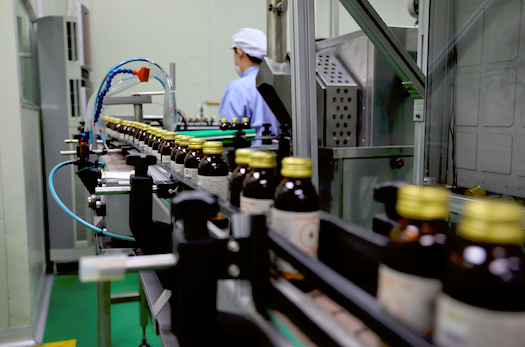
Co-manufacturer.
The process of launching a company isn’t rocket science, but it does take you on a journey of discovery that is an absolute thrill for anyone who enjoys difficult challenges and learning on the fly.
What we learned in the validation to pilot stage was a crash course in international supply chain management, brand design, product development, and the power of just reaching out when in need. We have consistently been surprised at the generosity of the food and beverage community and their willingness to offer advice when it is asked for.
Describe the process of launching Bissy Energy.
We live in an incredible time as entrepreneurs. Never in the history of business has there been a better climate for launching and running a start-up. From an ease of doing business perspective, it is as simple as registering your entity with the state of your choice (we chose Delaware), applying for a trademark on your word and logomark through the USPTO (this isn’t really even necessary but highly recommended if you want to scale), creating an ecommerce website through someone like Shopify, and listing your products.
On the product side, there is no shortage of third-party developers, creatives and experts at your disposal through individual contractors working in the gig economy through Upwork or Fiverr. For Bissy we hired a friend of a friend to help us with our logo, worked with a developer from Fiverr on some custom Shopify code, contracted a third party to develop our formula, and trusted in a manufacturer to pack and fill our formula. We did the rest, but a big chunk was handled by others.
Related Case Study: How Two Moms Launched Keto Cracker Company Defy Foods
When it comes to marketing and sales, things have also never been easier. An entrepreneur today can employ a number of strategies for free to immediately elevate their online presence. From SEO strategy, email tools like MailerLite, CRM management tools like HubSpot, and social accounts like TikTok, Instagram, Twitter, and Facebook, it has never been easier to communicate your message, find people who need your products, and track your progress. And for the most part all of it is free.
Financing is perhaps the most difficult challenge in running a business. You can have a killer product with fantastic packaging and even a loyal following of customers and still run out of money trying to scale. However, the same truths about our current state of entrepreneurship hold true; it has NEVER been easier to find money than it is today. Thanks to founder friendly investment vehicles like SAFE agreements and Convertible Note agreements, raising capital from family, friends, and Angels is as easy as finding a template agreement, doing some research, choosing an appropriate valuation cap and discount, and then pitching your list of targets.
If family and friends aren’t in a position to help, get on Google and look for Angel networks in your area, find names, get on LinkedIn, and start sending messages. Obviously this doesn’t guarantee investment, but we do guarantee you’ll get some responses; successful people like to help driven entrepreneurs because they once were where you are.
Early on an advisor told us “If you want investment, ask for advice. If you want advice, ask for investment.”, something that has stuck with and held true throughout our journey.
So your family and friends have run out of money and your angel network is dry but you obviously still believe in the product and the business, what do you do next? Go to Kickstarter, Indiegogo, or any of the other ten crowdfunding sites that are popular and available on the world wide web. These crowdfunding sites are incredible tools for not only raising money, but for validating your idea. Then, if you implement the right strategy and are able to get funded it opens up the next and most valuable stage of crowdfunding platforms – product validation and customer acquisition.
For Bissy this was our playbook; to tap our own savings, our family and friends that believed in us, and local angels for investment. Once we had enough to register the business, apply for our trademarks, set up our Shopify account, perfect our formula, prototype our packaging, and create a 3-minute introduction video, we went straight to kickstarter to validate the idea.
After a month of hustling, we were lucky to be funded for $30,300 which then allowed us to validate the product through surveys and retargeting efforts after fulfilling the kickstarter orders. To this day we have retained 18% of our Kickstarter customers.
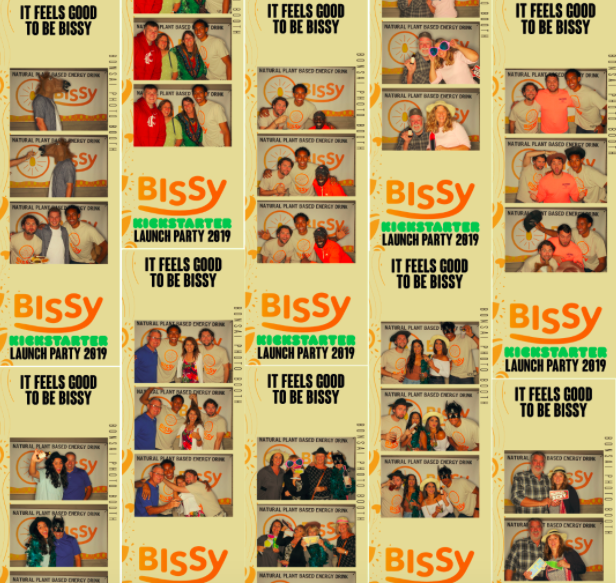
We hosted a series of launch parties with our networks in WA and CA to keep momentum going through the Kickstarter.
Since launch, what has worked to attract and retain customers?
In our experience, the key to getting started is to narrow your focus. Everyone wants their product to be for everyone, of course! Everyone is a MASSIVE market. But if your approach is broad you will find that your product isn’t for everyone, it is for no one. Start by looking at your total addressable market (TAM) and then go from there. Where can you find your evangelists? Great case studies exist for these types of launches but our two favorite food and beverage stories come from RxBar and Liquid Death Mountain Water.
RxBar is further along than Liquid Death, selling to Kellog for $600M in 2017 after only 4 years (!!!) of operation. RxBar is almost ubiquitous now with “protein bar” and “clean label” and has influenced products across the market with their simple, honest, “no BS” ingredients and branding – but they started in a basement and initially offered their products exclusively to Crossfit gyms around the Chicago area. We’ve never even so much as sniffed a crossfit gym, yet we love RxBars as a snack or even a meal replacement.

Our omni-channel marketing approach.
Liquid Death is another tale of targeted marketing going mainstream but, in many ways, taken to the extreme. The idea of Liquid Death was conceived of when one of the founders was at a heavy metal show and realized band members were filling up their sponsored energy drink cans with water to stay hydrated during shows. That led to two questions, “why is all water branded for yoga moms?” and “why can’t water be bad ass?”. Now, after marketing almost exclusively to the metal world, Liquid Death has gained national recognition and sells in WholeFoods Markets across the United States.
At Bissy, we are just trying to walk in the footsteps of those who have come before us. We are focusing our efforts on people who are most familiar with the kolanut, our low hanging fruit if you will. Kola is indigenous to West Africa and was brought to the Caribbean and the US by enslaved peoples during the transatlantic slave trade in the 1500’s before John Pemberton got ahold of it and created the original Coca-Cola formula. Bissy wants to put respect back on kola’s name by paying homage to the West Africans who grow it and our ancestors who have consumed it for thousands of years.
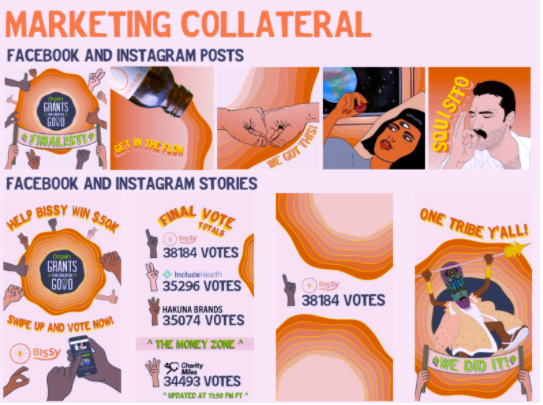
Bissy Energy Marketing Collateral.
Kola is still used as the primary source of caffeine in West Africa, Jamaica, and in the United States by the diaspora. This is the most natural market for us and we acquire many of our most loyal customers through a funnel that runs from Facebook and Instagram, to email list nurturing, to conversion in our Shopify store. Most retention occurs through facebook and google retargeting, email campaigns, and exclusive offerings.
We’ve tried a number of acquisition strategies but the ones that seem to pay off the most are those that offer something in return for an email. On this front we have ran campaigns for recipe books, quizzes to find out your West African Superfood, and early access to new product offerings.
We are still enjoying the fruits of our targeted core of loyal customers with room to grow there. Once we reach any stagnation in growth of our target we will broaden our message into related markets, building from there.
What does the future look like for Bissy?
To date, we have spent most of our time focused on our e-commerce strategy where there is the opportunity to interact directly with our customers. This strategy helps us understand the who and why of our most loyal fans so that we can further align our messaging and build out future product offerings they will love. Especially with COVID eliminating the ability to demo products in retail, the only way of getting to know your customers is now online.
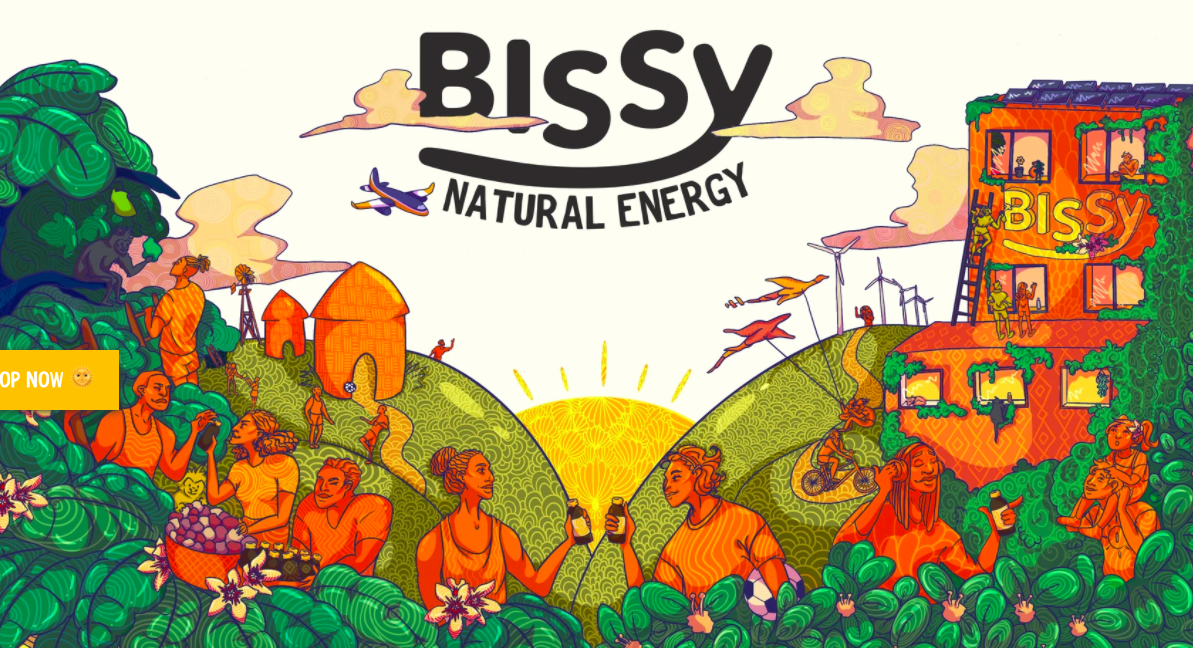
The official website of Bissy Energy.
Having recently launched our new powder bags, we are once again in the process of validating a new product but now with a loyal base of customers who inspired its development in the first place. We’ve already received preliminary validation through online channels and are now expanding our powder offering to Amazon where we were accepted into their LaunchPad program. On Amazon we hope to quickly capture the small but already existing market for kolanut powder and convert some dissatisfied coffee and tea drinkers into satisfied kola drinkers. For January we are targeting revenue of $5,000 across our two products and expect to launch more new products into the market later in 2021.
What have you learned from you business journey so far?
Naturally, as first time entrepreneurs much of our existence has been a comedy of errors and failures, some small, some large, some out of our control. In hopes of helping you avoid some of the same early mistakes we’ve made here is a list with some anecdotes:
KISS – Keep It Simple Silly
When we started Bissy we had a lot going for us as a brand. We had a great product, a unique hero ingredient, an exciting story, we were the most sustainable shot on the market, and had an inspiring social mission in Nigeria that we were passionate about. We were different and we wanted to own that.
But in trying to be so different we muddied the waters, taking an already unfamiliar kolanut product and packaging it in an unfamiliar brown glass bottle that wasn’t really a shot but also wasn’t really a full drink.
As we started to run demos at local markets and co-working spaces, we quickly realized that we had made some poor assumptions about the ways we thought the bottles would be perceived. Retailers didn’t know what to do with it and where we thought customers would be excited about glass bottle sustainability, they were mostly indifferent at best and at worst afraid to try Bissy because the bottles looked like medicine. We are pivoting from our original glass bottles to a regular 12oz aluminum can in the near future as a result of the feedback.
Have a backup
Supply chains are tricky and when you are using multiple ingredients that are being shipped across the atlantic and pacific oceans and back, things can become complicated. But when one of your key suppliers all of the sudden discontinues the product you had built your formula with, things can become downright tragic.
This is what happened to us after having already ordered all of our ingredients and shipped them to our co-manufacturer in South Korea. We had to go back to the drawing board on our formula and scramble to try and find a supplier who’s ingredient didn’t completely change the flavor of the product. We failed and a number of the other ingredients that were left sitting on the manufacturing floor in South Korea expired; we lost almost every dollar we had in the bank because of it.
No money, no second production run. This is why you should have a contingency plan set up with your development team. What happens if an ingredient disappears from a current supplier? Can you easily find a replacement that doesn’t ruin the formula? Good conversations to have beforehand.
You aren’t dead until you’re dead.
The name of the game is surviving. As long as your bank account says “$0.01” or more you are still alive. After losing our production run we immediately started reconsidering our strategy and took the opportunity to use tip number one “KISS” to reorganize the business, and retool our decks. Once we felt good about the new vision we started turning over every stone we could find. Grant applications, incubator applications, Angels, seed/pre-seed VC’s; we got turned down in almost every instance, but that didn’t matter.
We eventually found Orgain’s Grants For Greater Good program and we applied. Our application got us placed into the top six where we squared off for two straight weeks in a contest for public votes. We had a killer social media strategy and our community rallied behind us. We ended up placing 1st in the voting, winning $50,000 and reviving our business.

Our balance at the end of June 2020 before the grant came – as you can see we were all but dead.
What platform/tools do you use to run Bissy?
A good software stack can go a long way and really if you are going to be efficient it is necessary. We are bootstrappers so we go for the most bang for our buck – free is always best if you can get the quality you need.
We love Hubspot for tracking our retail leads and investor/angel leads. You can set and assign tasks, move leads through the funnel, assign leads to team members, there is a chrome/gmail plugin that allows you to schedule emails, and it also notifies you when the recipient opens the email – pretty cool.
We are also big fans of Slack as a communication tool and repository for various ideas or findings that we want to discuss and look back on. It also has some fun apps you can layer in to improve the experience.
Other apps we use that are absolute necessities are Shopify and DropBox. Shopify is a great app because not only is it your storefront, it is also a platform for hundreds of integrations (we use 15) and upgrades that can really beef up your store and make your life easier. Dropbox or a similar cloud filing system is also necessary if you are working with teams. Dropbox allows you to share, edit, and access files across devices with team members.
Kitchen utensils we can’t live without…
James: I couldn’t live without my Bialetti french press. I brew everything in there, from kolanut, to fresh ginger, mint, hibiscus, etc., I always have a cup of something warm in my hand. Also, my honorable mention is to the Aerogarden. I grow all my fresh herbs here, thai basil, dill, thyme, mint, lavender, chamomile. Currently I’ve also got a jalapeno plant going.
Zach: I love my NutriBullet blender. Every morning I wake up and the first thing I do is make a green smoothie complete with kola powder, ginger root, moringa powder, baobab powder, Orgain protein powder, spinach, kale, almond milk, a banana, chia seeds, and frozen fruit.
What have been the most influential books and podcasts?
Books:
The Prosperity Paradox: Written by Clayton Christensen (Harvard Business School), Efosa Ojomo (Harvard Business School), and Karen Dillion (Harvard Business Review) and discusses how the key to creating prosperity runs through entrepreneurs and a concept called “Market Creating Innovations”. We were saddened at the loss of Dr. Christensen earlier this year.
Things Fall Apart: Chinua Achebe’s first book and still his most popular. Achebe tells two intertwining stories, both centering on Okonkwo, a “strong man” of an Igbo village in Nigeria. The first, a powerful fable of the immemorial conflict between the individual and society, traces Okonkwo’s fall from grace with the tribal world. The second, as modern as the first is ancient, concerns the clash of cultures and the destruction of Okonkwo’s world with the arrival of aggressive European missionaries.
Podcasts: Both oldies but goodies
Taste Radio: Peter Rahal – RxBar – a must for anyone trying to build a brand that has dreams of exiting. Peter is a wealth of knowledge and also now runs Litani Ventures which he is using as a vehicle to invest in early stage food startups.
Brand Builder: Lisa Curtis – Kuli Kuli – Lisa’s ability to take an unknown West African superfood and bootstrap it into a kitchen staple is nothing short of remarkable. In this podcast episode she breaks down her strategy for marketing on a budget.
Advice for other food and beverage entrepreneurs starting out?
- Move as quickly as you can to turn your idea into a beta and start shopping it around.
- Use your ignorance to your advantage, bite off more than you can chew.
- Build a strong community, StartUp CPG is an incredible resource for this.
- Know your weaknesses and build a team that can fill in the gaps.
- Reach out to your heroes and ask for advice.
- Don’t let failure deter you, you will fail.
- Reach out to us and say hello!
Learn more.
Get a new founder case study like this one delivered to your inbox each week by signing up for our 40,000+ food business community.

